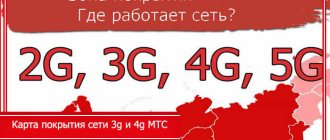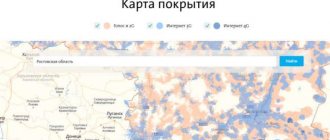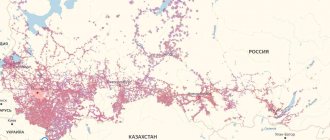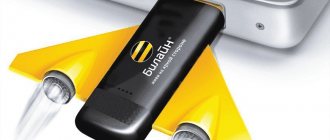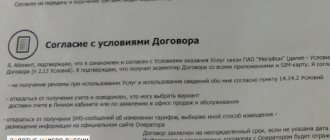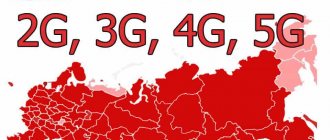Beeline coverage map and its features
Having studied the map of the location of the operator’s communication towers, you can see that the entire country is covered by them.
But communication is not always present where there are well-equipped mobile operator stations. Why so, you ask. Many users who do not know about the features of mobile communications attribute problems with it to the service operator. But this is far from true.
Network quality depends on many factors:
- Insufficient signal emission power from the base tower or incorrect direction of the antennas.
- Uneven distribution of base stations due to the peculiarities of the geographical location and architectural development of the settlement, resulting in incomplete coverage of the territory.
- The quality of communication also depends on the density of the area , the layout of the building in which the subscriber is located, or even on the thickness of its walls.
- Weather conditions play an important role - for example, rain greatly affects the throughput of communication channels.
Basically, the subscriber wants to know about the quality of communication and coverage area in the following cases :
- Buying real estate (most often outside the city).
- When going on a trip, picnic or vacation.
- Going on a business trip.
Below you can see the coverage map:
By the way, on the map, large cities are generally shown with the best signal, but remote settlements, so to speak, the outback, cannot boast of this.
But here a surprise may await you - although the tower may not be indicated on the map, the operator’s connection in this area can be quite tolerable.
For what reason does this happen? Most often, a reflected signal is involved in this, although small inaccuracies in drawing up the coverage map cannot be ruled out.
Let's see on the map how Beeline's 4G coverage area has changed in the Novosibirsk region
The list of places where Beeline mobile communications has received noticeable improvements has been added to 11 streets and 12 settlements in Novosibirsk and the region. Towers equipped with equipment that allow maintaining both voice communications and 4 G
These included: Prigranichnaya, Fasadnaya, Tvardovskogo, Arbuzova, Voinskaya, Bolshaya, Stantsionnaya, Sibiryakov-Gvardeytsev streets in the area of pl. Kirova, Gorsky microdistrict, Savvy Kozhevnikova, Severny proezd, as well as SNT Veteran-3, SNT Nedra, st. Zapalnaya in the village of Krasnoobsk, Green Island district of Berdsk, Mochishche, village. Novoluvoye, s. Kamenka, st. 1st Izvestkovaya in Iskitim and the village of Keramkombinat in the Iskitimsky district, the holiday village "Maryino Estate" in the Krivodanovsky district, the villages of Iskra and Maisky in the Cherepanovsky district, the village of Svetly in the Kochenevsky district.
You can find out whether there are plans to improve communications in the area, town or dacha community you are interested in in 2020-21 by sending a request to the Beeline press service by email: [email protected]
“Now we are sharing only the first small results, but behind them there is serious work, which has already been partially completed, and which remains to be done. Since last fall, we began preparing for a large-scale project to improve the quality and coverage of voice communications and 4G, planned for this year and 2021: we studied the needs of the region’s residents, looked at where we are lacking, where we need to be further strengthened, where we need to work for the future. This helped us identify key areas for ourselves, because communications should develop in proportion to the city and region. Our team is making every effort to soon announce improved communications in a number of new areas of the city, holiday and cottage villages under construction, as well as inside large shopping and business centers,” shared Beeline territorial manager in Novosibirsk Viktor Kochetov.
In 2021, Beeline in the Novosibirsk region has already increased 4G coverage by 1.5 times, launching for the first time or strengthening communications in 90 settlements in the region, on 44 streets of Novosibirsk, in Berdsk, Iskitim, and on the territory of the Tolmachevo airport. When launching 4G in the Novosibirsk region, special attention was paid to popular destinations for summer holidays.
The editors of KS are open to your news. Send your messages at any time by email or through our groups on Facebook and VKontakte
Subscribe to the “Continent of Siberia” channel on Telegram to be the first to learn about key events in the business and government circles of the region.
Found an error in the text? Select it and press Ctrl + Enter
COMMENT
SUBSCRIBE
Where can I get 3g and 4g signals from Beeline?
Having carefully studied the Beeline coverage map, you will notice that the Internet of these categories is not available everywhere. The best signals of 3g technology can be received in the central part of the country, but in the eastern and northern regions the situation is worse.
Regarding the Internet using 4g technology, the coverage here is much more modest. Base stations with this signal are located pointwise, which means that not all operator users can receive the signal.
4g Internet can be used by residents of the Moscow and St. Petersburg megacities, as well as their regions. Residents of certain central regions of Russia also have this advantage.
In other regions of the Russian Federation, 4g signals appear only in the largest cities - administrative centers of the regions where Beeline LTE base stations are located. This service is provided in 11 regions of the country, increasing its volume to cover more and more new territories every year.
Signal reception problems and how to solve this problem
As mentioned above, the absence of a signal or its poor quality occurs everywhere. And the operator is not always the reason for this. Now we would like to tell you what you can do if you have a bad operator signal on your phone.
Of course, complaining about a small number of base stations or their insufficient power will not speed up the process of installing new ones or upgrading old ones.
But by sending a request to the operator indicating your location and the characteristics of the signal you are receiving, you can be sure that the operator will definitely consider this request and check the settings of its stations in this region, which may simply need additional correction. That is why feedback from its users is very important for Beeline.
In addition, the problem may lie in the gadget itself, which simply does not receive a signal due to the fact that it does not support this type of communication. To avoid this, when purchasing equipment, be sure to ask the seller about the functions of receiving communication signals.
To solve connection problems in remote areas of the region where the signal does not penetrate well, such as in the country, you can install special cellular amplifiers.
It is also worth paying attention to the time of registration on the network. The fact is that during peak hours, when the network experiences a large influx of users, the signal scatters and there simply may not be enough for everyone, or its quality begins to “limp”.
It will be useful to view:
Quality parameters
In fact, the access speed and signal quality may differ from those declared by the operator. Let's consider the reasons affecting the network distribution parameters:
- High load on the provider's station (BS).
- Bad weather conditions.
- Unique landscape and architectural features.
- Features of the emitter and its power.
- The number of base towers located around the consumer and their distance.
All this affects the quality and level of signal reception.
Grand total
In order to be connected, users need to have an idea of the quality of communication in the area where they are located. To do this, the Beeline operator has posted a very accessible map of its network coverage on its website. If the subscriber is not satisfied with the signal quality, the company is always ready to listen and help solve the problem. In addition, today the solution to many connection problems is not limited to adjusting antennas at base stations, but you can find out exactly what solutions to problems exist in this article.
Why know where cell towers are located?
Knowing the exact coordinates is of no use to the average subscriber - he will not even be able to distinguish the towers of one operator from another. But sometimes this data is necessary and important. Base station (BS) coordinates are required:
- When setting up directional antennas in a suburban area, the signal quality outside cities is low, which is why subscribers are forced to install transmitting and receiving antennas with amplifiers. These antennas require precise targeting to nearby BSs. The specialists involved in setting up this equipment know the coordinates of the towers. The same knowledge will be useful to those who decide to install the antenna themselves - the services of specialists are quite expensive (up to 4-5 thousand rubles);
- To set up indoor signal amplifiers - such devices are sold in communication stores and are directional antennas for desktop installation. We place the antenna on the windowsill, point it at the nearest BS, install a modem at the antenna’s focus and check the signal level - if the antenna is effective, the level will be higher, which will have a positive effect on the Internet speed;
- To choose a place to live - some people are afraid of base stations, preferring to live at some distance from them. Using special applications, you can clarify the coordinates of the nearest towers and select the optimal area for living.
Also, knowing the coordinates will help you find out whether communication from a particular operator will work in a given area.
Official websites of operators
Here are links to official maps of mobile operators:
- MTS - the page shows the service area in three standards, from 2G to LTE. Here you can also clarify plans for the development of fourth generation networks and see the coverage for the Internet of Things NB-IoT;
- MegaFon - network coverage map, including in the LTE-Advanced standard with speeds of up to 150 and 300 Mbit/s. Here you can also clarify the coverage at metro stations and the location of branded service offices. And one more map for determining the minimum speed for “Create Wi-Fi” tariff plans;
- Beeline is a universal map showing the location of offices and reflecting network coverage;
- Tele2 – coverage of 2G, 3G and 4G networks, as well as LTE 450 networks for high-speed Internet in remote areas (using modems from Skylink);
- The motive is a universal map of offices and coverage areas. Don't forget to check your service region.
Please note that there are no 2G networks from Tele2 in Moscow and the Moscow region. To access cellular communications, you will need devices that support 3G and 4G. The same applies to virtual operators working at Tele2 base stations in the capital and Moscow Region.
Special programs and applications
The most popular application for finding nearby base stations is Netmonitor. Shows the location of the nearest BS, provides a wealth of service information, and displays a map of the area. NetMonitor also supports displaying public Wi-Fi hotspots.
Another application, OpenSignal, gave good results. It has a built-in compass that allows you to get accurate orientation to the base stations of cellular operators. The signal strength at certain points is also displayed here - this data is collected from application users and will allow you to evaluate the real reception status.


